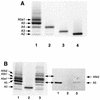Identification and characterization of the N-acetylglucosamine glycosyltransferase gene of Haemophilus ducreyi
- PMID: 12228324
- PMCID: PMC128345
- DOI: 10.1128/IAI.70.10.5887-5892.2002
Identification and characterization of the N-acetylglucosamine glycosyltransferase gene of Haemophilus ducreyi
Abstract
Haemophilus ducreyi is the causative agent of chancroid, a sexually transmitted ulcerative disease. In the present study, the Neisseria gonorrhoeae lgtA lipooligosaccharide glycosyltransferase gene was used to identify a homologue in the genome of H. ducreyi. The putative H. ducreyi glycosyltransferase gene (designated lgtA) was cloned and insertionally inactivated, and an isogenic mutant was constructed. Structural studies demonstrated that the lipooligosaccharide isolated from the mutant strain lacked N-acetylglucosamine and distal sugars found in the lipooligosaccharide produced by the parental strain. The isogenic mutant was transformed with a recombinant plasmid containing the putative glycosyltransferase gene. This strain produced the lipooligosaccharide glycoforms produced by the parental strain, confirming that the lgtA gene encodes the N-acetylglucosamine glycosyltransferase.
Figures




References
-
- Al-Tawfiq, J. A., A. C. Thornton, B. P. Katz, K. R. Fortney, K. D. Todd, A. F. Hood, and S. M. Spinola. 1998. Standardization of the experimental model of Haemophilus ducreyi infection in human subjects. J. Infect. Dis. 178:1684-1687. - PubMed
-
- Bozue, J. A., L. Tarantino, and R. S. Munson, Jr. 1998. Facile construction of mutations in Haemophilus ducreyi using lacZ as a counterselectable marker. FEMS Microbiol. Lett. 164:269-273. - PubMed
-
- Bozue, J. A., M. V. Tullius, J. Wang, B. W. Gibson, and R. S. Munson, Jr. 1999. Haemophilus ducreyi produces a novel sialyltransferase: identification of the sialyltransferase gene and construction of mutants deficient in the production of the sialic acid-containing glycoform of the lipooligosaccharide. J. Biol. Chem. 274:4106-4114. - PubMed
Publication types
MeSH terms
Substances
Associated data
- Actions
Grants and funding
LinkOut - more resources
Full Text Sources
Other Literature Sources

